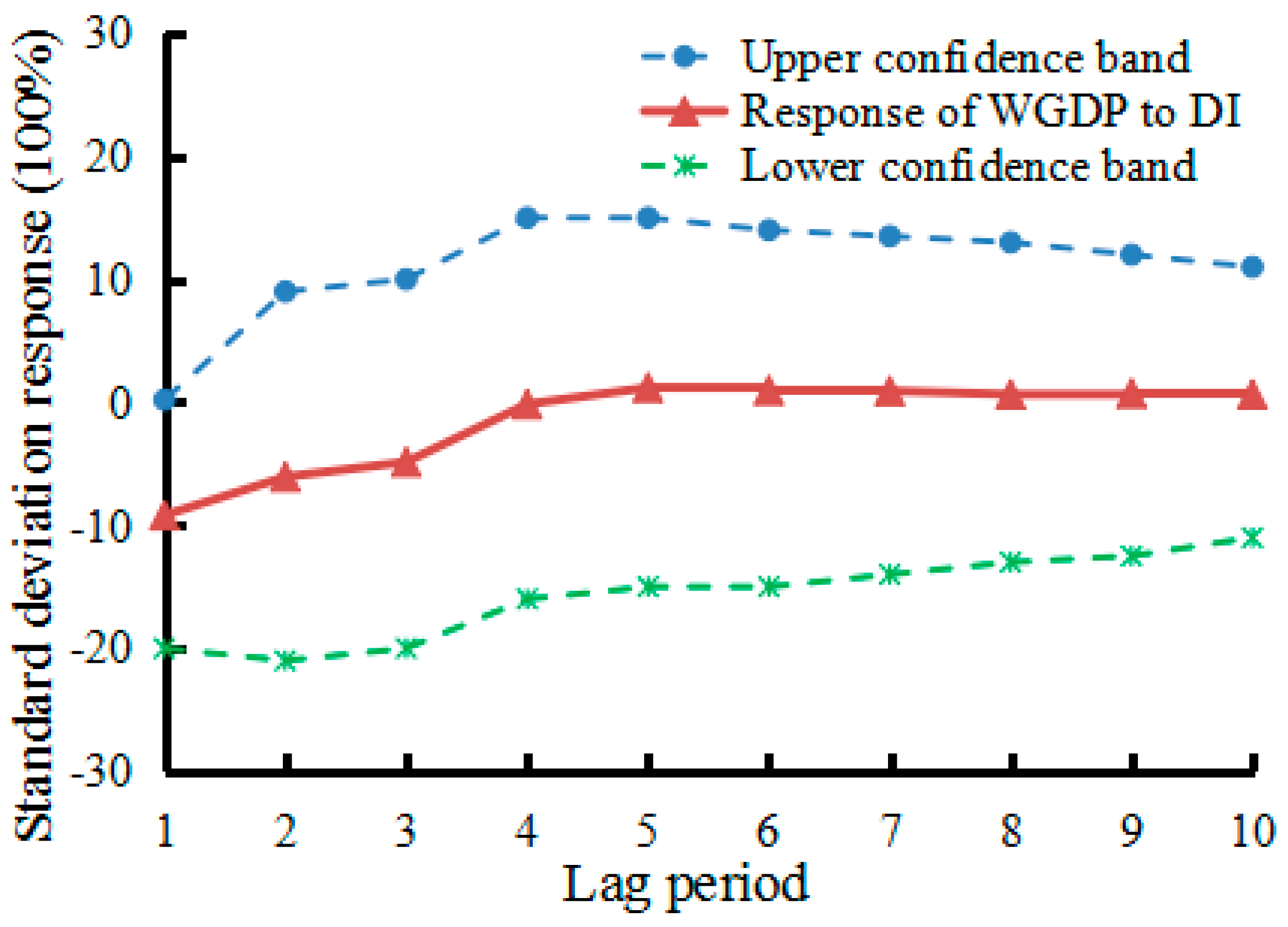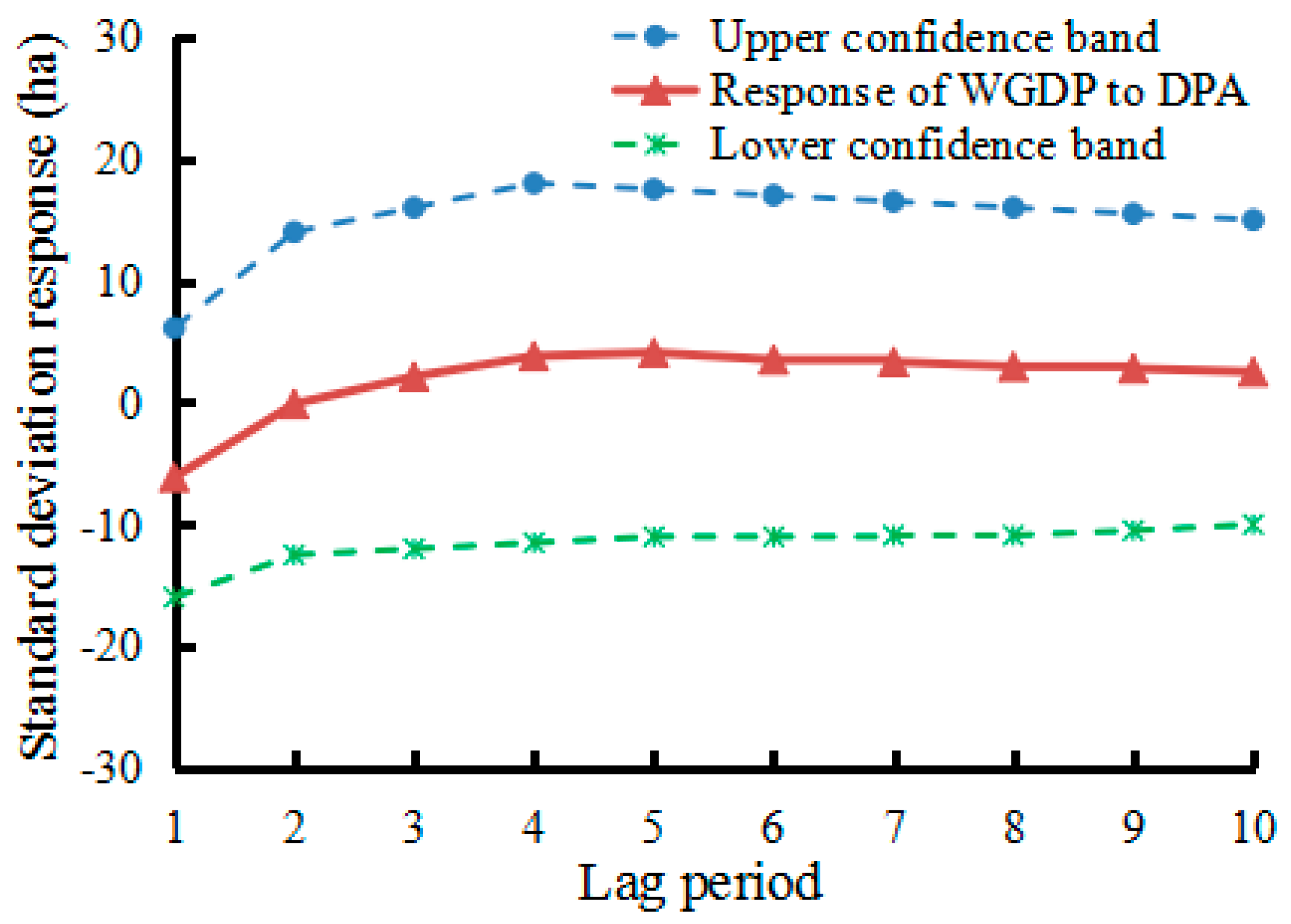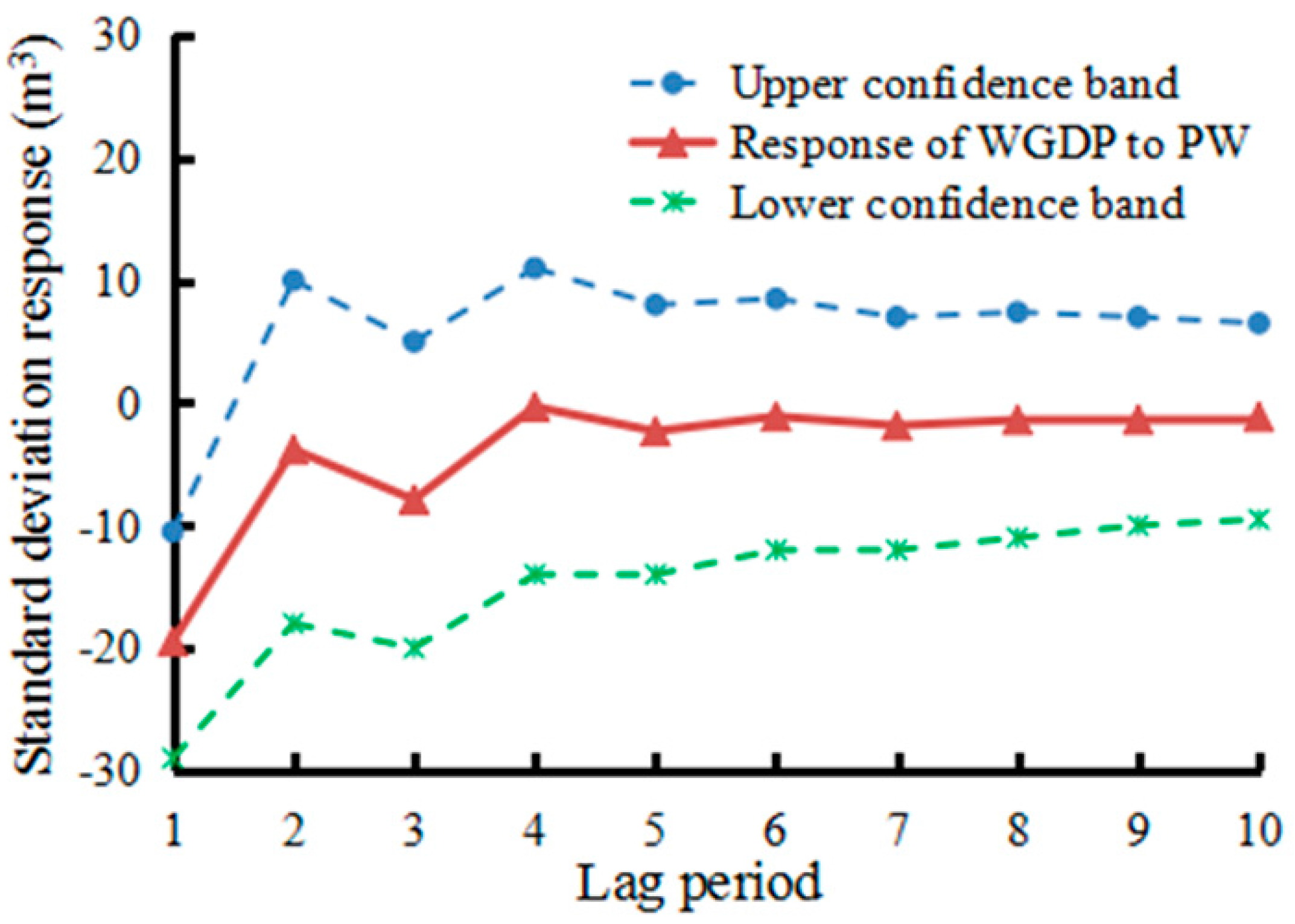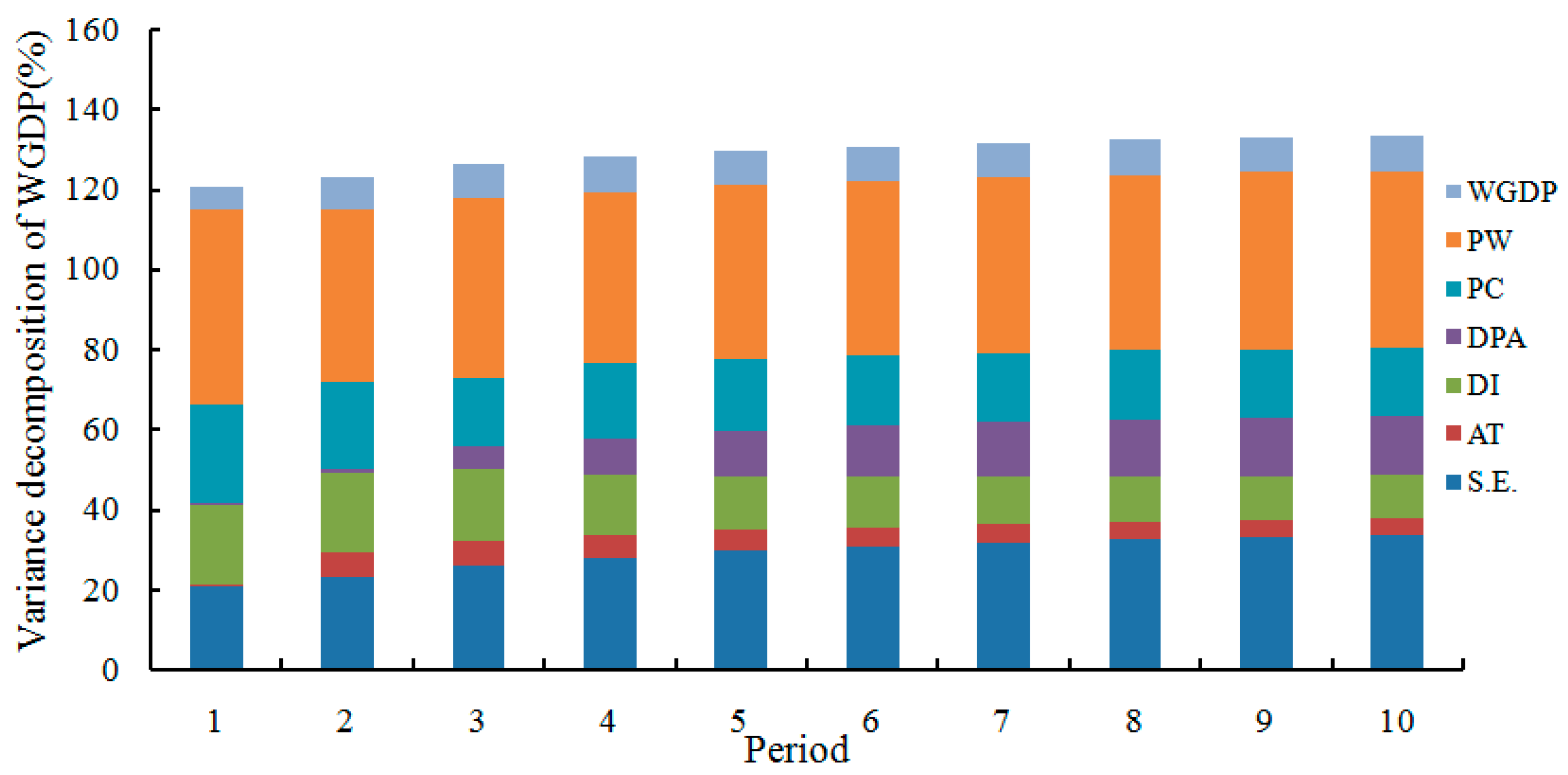China’s per capita share of fresh water resources is about 2100 m
3, just 28% of the World’s average. Furthermore, two thirds of China’s cities are short of water, and one fourth of these cities are in serious situation. The negative influence of water shortage on China’s economic growth reaches 1.0%–2.0% currently, higher than the impact of rising energy prices. Thus, the shortage of water resources has become one of the significant bottlenecks restricting China’s economic and social development. In addition, the water utilization mode is still extensive with low efficiency in China nowadays. For example, on World’s average, 711 m
3 water resources should be consumed to create ten thousand dollar GDP, but in China, this figure is 1197 m
3 (about 1.7 times World’s average). Moreover, the China’s water consumption distribution is unbalance from the geographical perspective. Water consumption per ten thousand dollar GDP is 145 m
3 in east of China, and the figures are 294 and 429 m
3 in middle and west, respectively [
1].
In sum, the water use situation in China can be concluded as follows: the per capita share is small, the water use efficiency is relative low, and the regional difference is obvious. As such, in order to adapt to the rapidly expanding economy and to enhance the water use efficiency, the government of China plans to take some measures to enhance the management of water quota. Under this background, the government of China put forward higher request for the water use efficiency. For this target, the government of China needs to screen out the influencing factors of comprehensive water use efficiency, and we need to investigate the factors’ impact on water use efficiency. Jiangsu Province is chosen as a case study in this article. Jiangsu is a huge province with large population and developed economy. Its total annual water consumption accounts for about 9% of the whole country’s water use amount. These years in Jiangsu, water consumption per ten thousand dollar GDP appears to be stable, but water ecological environment protection pressure is still large. Owing to the significance of Jiangsu Province’s water use situation in China, the local government in Jiangsu put forward the “Comprehensive planning of water resources in Jiangsu Province”. In the plan, by 2020, the provincial total water consumption must be limited to no more than 59 billion m3, and water consumption per ten thousand dollar GDP must be cut by 51% to 90 m3 from 180 m3 in 2010. To achieve this goal, we need to fully understand the change characteristics of water consumption and the influencing factors on comprehensive water use efficiency in Jiangsu. Thus, we should conduct the factor identification to figure out the effect of various factors on the change of the comprehensive water use efficiency, so that the government could find further direction and countermeasure to reduce water consumption in Jiangsu.
In recent years, many scholars have conducted in-depth analysis and research on the change mechanism of water use efficiency, focusing on four aspects. One is the research on the driving force of the main factors affecting the water use efficiency. Dawadi et al. [
2] have paid close attention to the influence of growing population and changeable climate on the water resources in the semi-arid region. The research shows that the rapid growth of the population and climate change is a key factor affecting the sustainable utilization of water resources. Pereira et al. [
3] considered that the water use performance descriptors may be useful in defining the saving of water, so that the overall productivity of water use can be improved. Then, they thought the indicators about water use efficiency must consider the water reuse to identify and provide clear differences between non-beneficial and beneficial water-use. It is recommended that a set of terms be widely adopted that will provide wide spread common understanding of the issues that must be faced by efficient water use, such as rainfall factors, irrigation management, technical means, agronomic cultivation, and adaptability to environmental changes. Cao et al. [
4] applied the Moran’s I analysis to study the water productivity indices of China explaining the clustering degree of the indices in global and local area. After analysis and calculation of 459 irrigated areas’ water productivity indices of China in Cao’s paper, it is shown that almost all of the provincial water productivity increased from 1998 to 2010 in time and space. According to the summary of the literature, commonly used evaluation indicators of water use efficiency are: irrigation water use efficiency and water productivity [
5], virtual water content and water footprint [
6,
7], and water profit [
8]. Second aspect is the research on the evaluation methods of water use efficiency. Wang et al. [
1] tracked the trajectory of agricultural water use variation in Heihe River Basin of China based on Data Envelopment Analysis, then they used Tobit model to investigate the influence of driving factors on the water use efficiency. In Wang’s paper, the water use efficiency directly affected the water consumption of agricultural production, and it is very important for the protection of water in local and regional areas. A variable fuzzy assessment model was established in Wang’s paper to assess the water use efficiency in Beitun district of China [
9]. Five indices were selected as evaluation factors, canal water utilization coefficient, field water utilization coefficient, crop water productivity, effective irrigation rate in farmland, and water-saving irrigation area ratio. Li et al. [
10] figured out an effective irrigation water allocation mode under uncertain conditions. Mariana et al. [
11] applied rapid identification process in the evaluation and diagnosis of 22 medium-sized communities’ irrigation scheme in the Sahara, and the results show that the backward irrigation management and maintenance is a major cause of the decline in the efficiency of water. The third aspect is the research on agricultural water saving irrigation measures. Water-saving irrigation and drainage system and supervising system was integrated to compute the water use amount, crop yield and pollution load in Gaoyou irrigation area of South China [
12]. The calculated irrigation water productivity was 45.3% and total water productivity was 31.6% in 2008, higher than that of the non-control system. Therefore, the practice of water-saving irrigation is helpful to reduce the potential of discharge, and thus control the drainage to reduce the irrigation demand. Fan et al. [
13] conducted the evaluation and comparison of water use efficiency of spring wheat, corn, onion, pepper, sunflower, cotton, melons and fennel in his paper. It is considered that in the behavior of irrigation and water saving, the economic benefits generated by the water saving measures should link to the cost of water saving measures. The water consumption, irrigation demand, water use efficiency of three rice producing areas in China were studied by using the validated rice growth model, and the characteristics of the four parameters were studied by Wang et al. [
14]. The research results show that the increase of carbon dioxide concentration is to promote the efficiency of water use in favor of reducing water consumption and increasing rice yield. Ma et al. [
15] proposed to implement water-saving irrigation to avoid the groundwater resources to run out in water crisis areas, so they selected three representative sites in North China Plain to demonstrate the performance of water-saving irrigation. For the research, the SWAP model was established under the different conditions of these three sites. The cropping system in sites is winter wheat–summer maize double cropping, and various hydrological years were set, so that we can see the distinctions about the groundwater recharge. The paper points out the advantages of spatial research methods: the data are sufficient, the simulation is accurate and the scope is wide. Disadvantages include: the simulation period is short and the parameters of different time series length change significantly. Hutton [
16] proposed the partial root dry irrigation method to promote water use efficiency and crop yields quality. The fourth aspect is the research on water footprint. Water footprint combined with the study of virtual water flow can better explain the relationship between grain yield and water consumption, which is of great significance to alleviate the shortage of water resources [
17]. At the same time, the implementation of total-cost pricing mechanism can effectively enhance the irrigation water use efficiency. In Sun’s study [
18], there was a review of water footprint assessment methods, which is a basis of the research of Hetao Irrigation District in China evaluating the water use efficiency and economic benefits. This study provided a new perspective of water use evaluation by water footprint, improving the comprehensive assessment of water use efficiency in irrigation. An improved calculation method was proposed to quantify the water footprint of crops by point scale [
19]. On this basis, the results showed that a decreasing trend of integrated crop production water footprint was presented because of the comprehensive influences of interannual climate variability, agricultural input fluctuation and other factors. By the soil and water assessment tool (SWAT), the Zarrineh River was chosen as a case in Ahmadzadeh’s work to simulate the actual irrigation management variables under different irrigation systems [
20]. For the sake of improving the simulation accuracy of the system, the SWAT has been modified in Ahmadzadeh’s work to carry out a comprehensive calibration based on a large amount data on hydrology and agriculture. According to the output of the twenty climate scenarios from the governmental data distribution center panel, Tao et al. [
21] used the changes of average monthly climate variables as the representative station’s median to simulate the baseline and future climate scenarios of maize production by CERES-Maize model. The results showed that the amplitude of climate change was the major factor of crop production and water use.
Based on the above literature illumination, the Jiangsu Province of China will be considered as the case study in this paper, and water consumption per ten thousand dollar GDP (WC/$104 GDP) indicates the comprehensive water use efficiency. Then the influencing factors of WC/$104 GDP in Jiangsu Province will be identified under the consideration of Jiangsu industrial development level and the different patterns and characteristics of agricultural, industrial and domestic water consumption. At last, we analyze the relationships between influencing factors and WC/$104 GDP for supporting government decision making. Because some influencing factors such as surface water resources (SW), groundwater resources (GW), precipitation (PT), per capita water resources (PW), per capita water consumption (PC), annual average temperature (AT), drought index (DI), per capita irrigation area (PI) and per capita arable land (PA) cannot be artificially altered, the dynamic system of these natural influencing factors need some input signals to produce the obvious fluctuation (output) to explore the subtle changes. As such, the impulse response is employed in this paper to describe the reaction of the real world system as a function of the independent variables of resource factors that parameterizes the dynamic behavior. Then the VAR model is used to generalize the univariate autoregressive model (AR model) by introducing all the resource factors to investigate their effectiveness.











